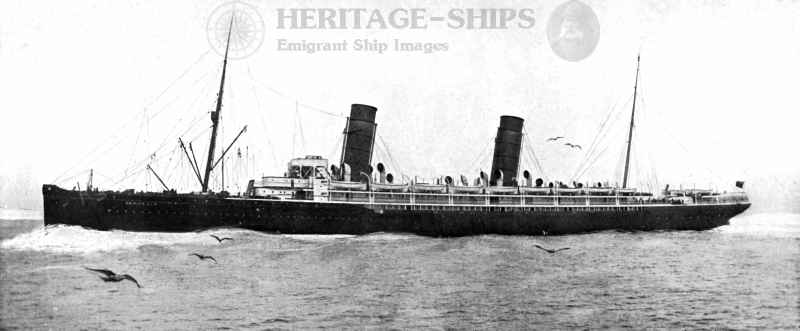 Campania, Cunard Line steamship |
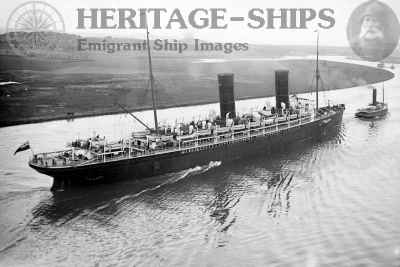 Campania - Cunard Line steamship, - Bird's-eye view Support Norway Heritage: Purchase a copy |
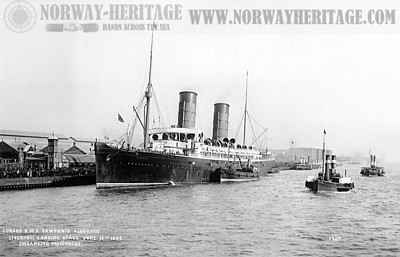 Campania, Cunard Line steamship at Liverpool Support Norway Heritage: Purchase a copy |
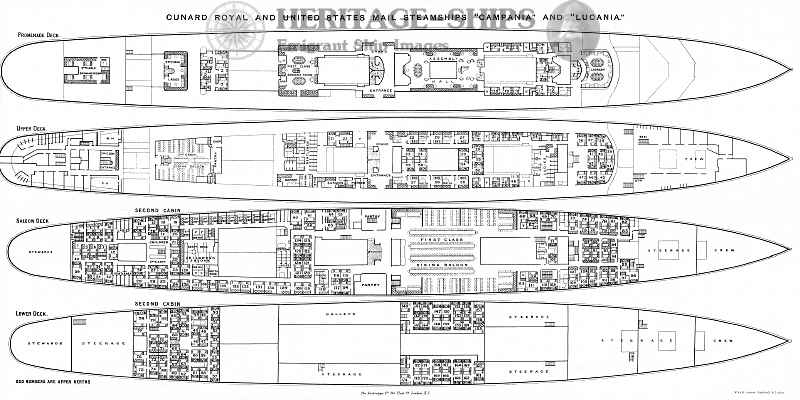 Deck plan showing the arrangements for the Lower deck, Saloon deck, Upper deck and Promenade deck of the Cunard Line steamships Campania and Lucania. Support Norway Heritage: Purchase a copy |
The Campania was the sister ship of the
Lucania. Official description published by the Cunard Line 1883:
OFFICIAL DESCRIPTION OF THE "CAMPANIA."
Length over all, 620 feet ; breadth extreme, 65 feet 3 inches ; depth from upper deck, 43 feet ; gross tonnage, 12,950 tons. The vessel has a straight stem and elliptic stern, topgallant forecastle and poop, with close bulwarks all fore and aft, the erections above the upper deck consisting of two tiers of deckhouses surmounted respectively by the promenade and shade decks. She appears in fore and aft rig, with two pole masts. In view of the gigantic proportions of the ship, it will be readily understood that the greatest care has been necessary both in the method and details of construction, in order that the requisite strength might be maintained throughout the entire structure. All the scantlings have been specially arranged, and every advantage taken of the improved sections of steel known as channel and zed bars, &c., in order to increase the strength without adding unnecessarily to the total weight. The vessel has been built under a special survey, and takes her place in the highest class at Lloyd's. The bulkheads, sixteen in number, are in excess of the recommendations of the recent Board of Trade Committee on the fitting and spacing of watertight bulkheads, and they will enable the vessel to float with any two, or in some cases three, of the compartments open to the sea. In addition to these qualifications the Admiralty requirements for armed cruisers in times of war have been complied with. The decks have been specially arranged and strengthened to carry guns, and steering gear of a special type fitted under water. Arrangements have also been made for the protection of the vital parts of the ship. The keel is of the flat-plate description, and a cellular double bottom, fitted with draining and flooding arrangements to make it available for water ballast, extends all fore and aft. The shell plating, which is in lengths of 26-ft. and over, is fitted on the lap-butt principle from the keel plate up to about the water line. Above that the plates are butted and fitted with double straps. The construction of the vessel at the stern is peculiar. Although fitted with twin screws, there is an aperture in the stern frame similar to that in a single screw steamer. This is provided that the propellers may work freely, though they are fitted close to the centre line of the ship in order to prevent damage to or from the quay walls. No struts are fitted at the stern frame to support the outer end of the shafts as in most other twin screw steamers. These are in the present case dispensed with, and the frames of the hull are bossed out and plated over right aft to form the stern tubes. At the outer ends of these, strong castings of steel serve the purpose of shaft brackets, and being in continuation of the lines of the hull are calculated to offer the least resistance to free propulsion. The rudder, which is fitted entirely under water, is of the single plate type, being formed of a heavy steel casting with massive arms, between which a thick plate is fitted and riveted. The whole arrangement, therefore, of the " Campania's " stern impresses one as uncommon in other respects than that merely of size.
Besides the superstructure already mentioned there are four complete tiers of beams, all of which are plated over with steel, and sheathed with wood planks, and form what are termed the upper, main, lower, and orlop decks. The last is used for cargo, refrigerating chambers, store-rooms, etc. ; while the others are entirely devoted to the accommodation of passengers, and contain the usual dining and social saloons. All the latest improvements are introduced, and everything calculated to render ocean travelling more comfortable and enjoyable provided. The casings around the boiler-rooms are double, the intervening spaces being filled with a material which is at once a non-conductor of heat and sound. The "Campania" is thoroughly ventilated by both natural and artificial means. The greater number of the sidelights are fitted with an arrangement for the free admission of air, even when during rough weather the lights are closed. A complete system of steam heating pipes provides for the warming of all `° the living spaces." There is also an installation of electric light on the most extensive scale. The "Campania" has two sets of the most powerful triple expansion engines that have ever been constructed. They are fitted with two separate engine-rooms on either side of a dividing centre line bulkhead fitted with watertight doors for the purpose of communication. Each set has five inverted cylinders—two high pressure, one intermediate pressure, and two low pressure, the high pressure pair being above the low pressure ones. These are arranged to work on three cranks set at an angle of 120 degrees from each other, and all have the same stroke. The high pressure cylinders are each fitted with a piston valve, the intermediate and the low pressure ones with double-ported slide valves, all of which are worked by the usual double eccentrics and link motion valve gear. The reversing engines are of the steam and hydraulic direct-acting type, made by Messrs. Brown Brothers & Co., Edinburgh. The reversing engines are also fitted with their patent automatic emergency gear. The crank shafts, which are all built, are interchangeable, and like the tunnel and propeller shafting, are of mild steel, forged by Messrs. Vickers, Sons & Co. (Limited), Sheffield. The condensing water is circulated through the condensers by four large centrifugal pumps, each driven by an independent compound engine. These pumps may also, if required, be used to pump water from the ship in case of damage to the hull. An elaborate system of piping is fitted throughout the ship, and connected to the various auxiliary pumps for filling and emptying the ballast tanks, pumping out bilges, pumping-water on deck in case of fire, and other purposes. In the engine room are also four evaporators to produce the necessary fresh water from sea water, and thereby make up the loss incurred through working, and avoid the use of salt water in the boilers. There is also a large feed water heater, two auxiliary condensers with pumps, and all the most modern appliances to economise fuel and labour. Steam for the main engines is generated in twelve large double-ended boilers. There is also a large single-ended boiler for supplying steam for the electric light, refrigerating and other auxiliary machinery. In addition, a small single-ended boiler is fitted on the lower deck for supplying steam to the distilling condensers, heating pipes, &c. The main boilers are arranged in two groups, having one funnel for each group.* (*the description applies also to the Lucania)
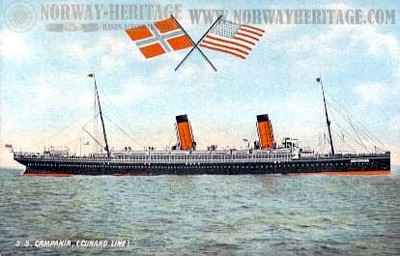 Picture of the S/S Campania, from an old postcard Support Norway Heritage: Purchase a copy |
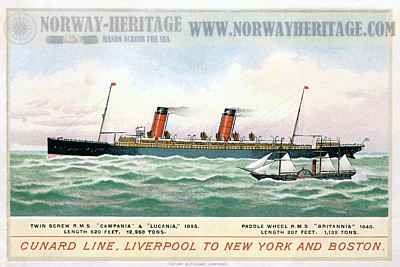 Steamships Lucania, Campania compared to the Britannia of the Cunard Line Support Norway Heritage: Purchase a copy |
These ships are 40 feet longer and of greater beam than any ship afloat, and only fall short by 72 feet of the proportions of that leviathan, the "Great Eastern." When fully loaded with cargo, passengers, and stores, their displacement reaches 19,000 tons, or about 3,000 tons more than that of any other vessel now afloat, merchant vessel or man-of-war. While the hulls of the vessels are almost unrivalled in size and in the accommodation they afford, the machinery by which the floating cities are propelled is unique for its magnitude and skill in construction. The two sets of
triple expansion engines in each ship — the most powerful that have ever been made — develope the enormous amount of 30,000 indicated horse-power. (It is amusing to remember that the first vessel of the Cunard Line showed 740 horse-power). The "Great Eastern" showed only 6,000 indicated horse-power ; and in this respect, therefore, the "Campania" and " Lucania " surpass every steamer, past or present, previously built, and as their lines are perhaps the most perfect yet designed, their speed should be proportionately great.
The funnels of the new vessels from their lowest section are 120 feet high, or about the height of the Eddystone Lighthouse, and their diameter 20 feet.
|
|
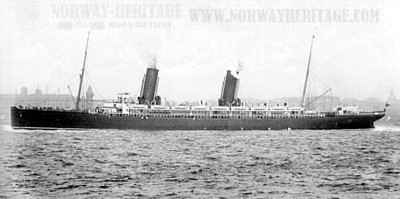 Campania, Cunard Line steamship |
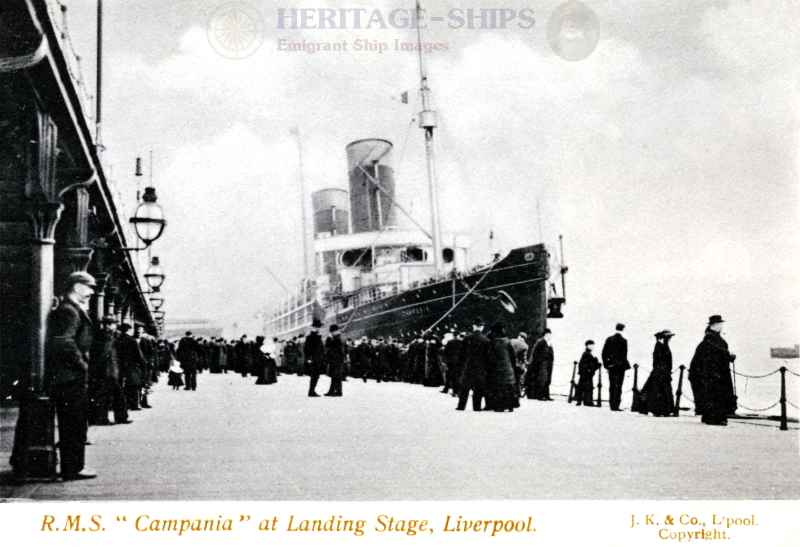 Campania - at the landing stage Liverpool Support Norway Heritage: Purchase a copy |
THE "Campania," the most magnificently appointed passenger vessel in the world, has been fitted up with a view to the greatest possible luxury combined with comfort, strength, durability, and perfect sanitary arrangements. The grand saloon, drawing room, library and smoking- rooms are noble in their proportions, and suggest the stately chambers of a palace rather than accommodation within the steel walls of a ship. It is worthy of special notice that comfort has been studied in every detail, and perhaps nothing exemplifies this more than the fact that in all the principal rooms there are coal fire grates, the first that have ever been used on board steamships. The electric installations made by Messrs. Siemens are in keeping with the other marvellous details of "the big Cunarder." There are four sets of generating plant in the "Campania," capable of supplying throughout the ship the 1,350 16-candle power incandescent lights — including eight large reflectors of eight lights each for working cargo and in addition a powerful search-light for facilitating the navigation of the ship into port, etc. Wire to the length of 40 miles runs through the ship.
THE GRAND ENTRANCE to the Main Staircase is on the promenade deck and is entered by large double doorways. It is well lighted ; the ceiling is ivory colour and the woodwork of teak, including the balustrade which is richly decorated between the arches with metal ornaments. From this spacious Entrance Hall two vestibules forward, one on either side, lead to the Drawing Room, and two passages aft to the Smoking Room. Descending the broad and handsome staircase, the upper deck landing, also furnished in teak, is reached. Here two fine doorways open on to the upper deck, and four passages lead, fore and aft, to the State-rooms. Descending again to the main deck the staircase terminates at the two principal entrances to the vast Dining Saloon.
|
|
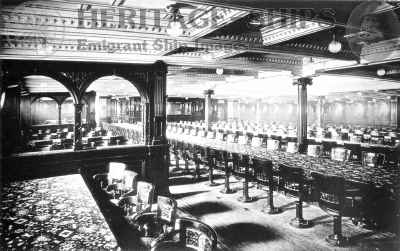 Campania - 1st class dining saloon Support Norway Heritage: Purchase a copy |
IN THE GRAND SALOON a startling surprise awaits the visitor. He has before him a magnificent Hall, in the modified Italian style, 100 feet long by 63 feet broad, with seats at table for 430 passengers. The grand mass of dark mahogany, richly carved, composing the walls ; the delicate panelling of the ceiling in white and gold, with electric lights in the centre of each panel ; the great crystal dome rising in the centre of the room through the two decks above to an altitude of 33 feet ; the splendid upholstery finished in dark russet velvet; and the graceful arches of ivory and gold with the frieze above them surmounted by the brilliant stained-glass colour of the dome ; have altogether a most striking and impressive effect. Not only in the Grand Saloon, however, but in all the principal rooms, and in fact throughout the ship, exceptional as is the beauty of the appointments, and vast as is the scale on which everything has been arranged, the primary consideration has been the comfort of the passengers ; and everywhere utility, ease, warmth, light and ventilation are to be found in perfection.
|
|
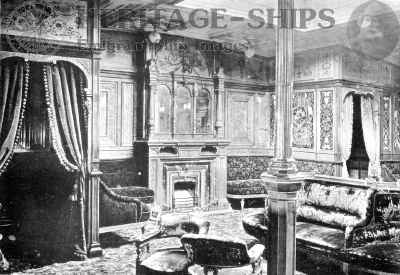 Campania - 1st class drawing room fireplace Support Norway Heritage: Purchase a copy |
THE DRAWING ROOM, on the promenade deck, has four entrances and is a spacious and lofty room in the Renaissance style, with walls of satinwood and cedar, enriched with beautiful carved work. It receives abundant light from two skylights, from the sides of the great dome, one of the most striking features of the vessel, and from prism lights and windows along-the sides of the room. The windows are of great strength, set in brass frames opening from the inside, and have ventilators above, which can be regulated so as to admit fresh air in all weathers. The sides of the dome, which rises through the centre of the room, are of satinwood panels, relieved with cedar to a height of four feet, over which are arched casements of bevelled glass. The frieze is surmounted by an ornamental cornice. The ceiling is panelled on simple lines, and painted in light tones, the dividing beam mouldings meeting the pilasters on the frieze. On either side of the fireplace are recesses, round which are cosy settees covered in rich dark velvet. These recesses are arched with cedar mouldings and draped with rich portieres. The stained glass in the sides, carried out in carved lines and flower centres, is of fine quality, colour having been discriminately used and the tints arranged with subtle effect and tone. At the after end the two entrances are arched and draped in similar style. The mantelpiece is elaborately carved and surmounted by arched mirrors, and the ornamental frieze above the rich wood paneling of the walls is executed in stained woods, in harmony with the other embellishments. The grate, built in, and protected with asbestos, has a sliding blower, and the fender and other fittings are of brass, highly finished, the hearth being laid with Anglo-Persian tiles. The Organ is of the same woods as the surroundings, the gilded pipes rising to the height of the frieze, and the keyboard having a panelled cover which slides out of sight. The Grand Piano stands opposite, of satinwood, designed and, like the organ, specially made to the orders of the Company. The furniture is all in satinwood, upholstered in a variety of superb coverings ; a heavy pile carpet covers the floor, and about the room are ottomans, settees, revolving chairs, card tables, and everything that can conduce to pleasure and comfort.
THE FIRST—CLASS SMOKING ROOM, entered from the promenade deck and also from passages leading to the Grand Entrance, is built entirely of fumed oak and is fitted up in the Elizabethan style. It has a coach roof and piazza arrangement along the sides, with table in each recess fitted round with settees covered in hogskin. The ceiling is divided into panels by moulded beams with bosses. The fireplace has sides and hearth of blue tiles fitted with dog-grate and accessories, all of solid bronze. Asbestos is also applied here as a precaution. The overmantel, which is elaborately carved, reaches the ceiling. On each side of the fireplace are settees with tables and chairs in front. The Bar is at the opposite end of the room. The abundant sitting accommodation, includes two large ottomans divided into luxurious lounges. The room is lighted by a large skylight, by prism lights in the frieze over the recesses, and by windows in the sides which are fitted with blinds and have ventilators above. Altogether, the effect is most inviting and the room a most comfortable retreat.
THE LIBRARY, at the forward end of the promenade deck, differs in form from any of the other rooms. It is fitted in mahogany, of a rich colour, delicately carved, and relieved with panels of amboyna wood. Under the windows are placed tables with morocco tops for writing or reading, and fitted with stationery cases containing every requisite to tempt correspondents. To each of these tables are fixed revolving chairs. The large bookcase follows the shape of the end of the room and extends across nearly its whole breadth. It is richly carved and panelled with amboyna, the upper portion being fitted with glass doors and ornamental astragals. Large ottoman lounges, in Mecca and other velvet coverings, are fixed between the pillars supporting the roof. The ceiling is of carved wood, painted in light tints. The floor is laid with parquetry, and covered in the centre with a Persian carpet.
THREE CLASSES OF PASSENGERS are carried by the "Campania," namely, First, Second, and Steerage; and roughly speaking there is accommodation for about 1,400 passengers, and 400 crew. The steerage quarters are forward, the second class aft, and the saloon amidships.
THE SECOND CLASS CABINS are so finely fitted that they are equal to the saloon accommodation on many other ships. There are about fifty state rooms in the part of the vessel devoted to the second class, together with a handsome Dining Saloon in oak wainscot ; an elegantly furnished Drawing-room in satinwood ; and a comfortable Smoking-room.
THE STEERAGE ACCOMMODATION is in every respect excellent, and far in advance of that usually provided.
|
|
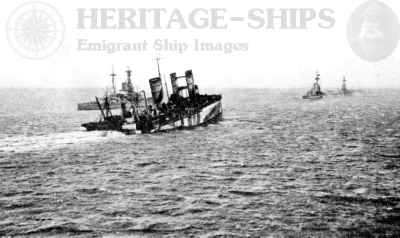 Campania as a WW1 seaplane carrier - here seen sinking in Firth of Forth after collision with a battleship Support Norway Heritage: Purchase a copy |